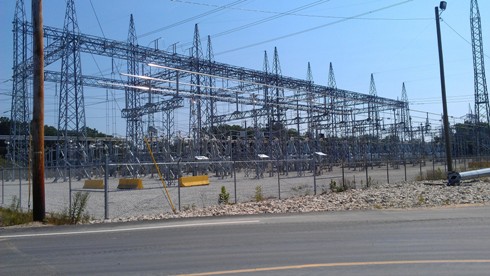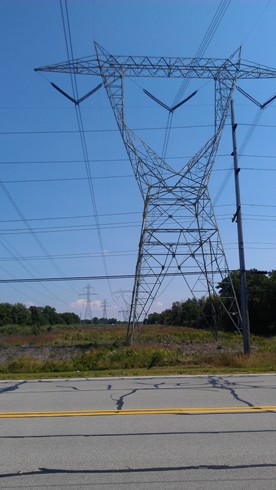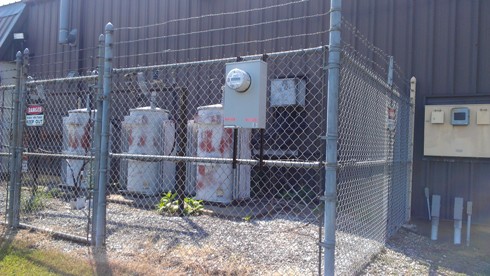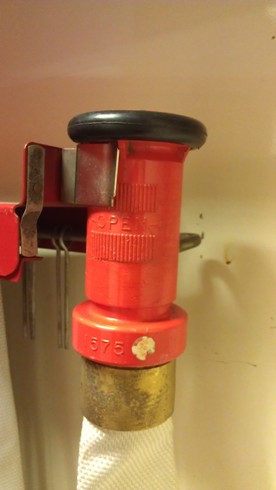By Christopher Huston
Scenario: Your engine company has been called to respond to a piece of equipment on fire at a manufacturing plant. You arrive on scene and are met by the machine operator, who states that he is the only one in the shop. As you obtain more information, the employee informs you the machine is still energized. At this time, thick, black smoke is issuing from the main entry door.
Since this scenario involves electrical equipment on fire, how would extinguish this fire with the tools you have on your engine?
An incident involving electricity increases the level of risk to both the customer and the responder. Our apparatus arrives with tools and equipment that can mitigate the fire but not the of flow electricity. The utility company can usually be on scene in a reasonable amount of time. However, we should have the knowledge, skills, and tools to reduce the fire hazard when live equipment, arcs, and sparks are creating a problem.
Every year, tens of thousands of people are injured from electricity. In fact, electrocution is among the top 10 reasons for death.
The path to better understanding firefighting operations and electricity must begin with what electricity is, how it is delivered, and how to shut it off. One key element that makes a fire a Class C fire is ENERGIZED electrical equipment. Once deenergized, the fire will be based on the type of fuel involved and should be extinguished accordingly.
Electricity is an energy source coming from the movement of charged electrons and protons. An electrical current is then created when those charges move from one place to another by a conduit with a voltage present. Voltage is the electrical potential difference. The flow can provide the necessary energy needed to power devices. This form of energy is produced by a generating station. The output of electricity is measured in watts, which describes the rate of energy transfer.
Electrical power stations can create electricity using multiple methods including wind, solar, coal, hydro, and nuclear. One particular power station can create more than 2,000 megawatts of electricity from its two operating generators.
This output then travels through the power grid, which is made up of transmission lines, substations, transformers, and service lines feeding the buildings we inhabit. Thus, the main switch in our homes is a critical piece in the overall system. We have a general understanding of how electricity is made and how we use it. Yet, the piece in the middle goes unnoticed.
The power distribution grid is a critical component; this is the means to deliver electricity from the source to the consumer. The grid is made up of thousands of miles of lines and many substations that distribute the power to where it is needed. These grids can range between 1kV (kilovolt) and 765kV based on the capabilities of the source. The power lines coming from switch yards step up the voltage for delivery over long distances by the transmission lines. Power is then delivered to substations, where it connects our homes and offices by using distribution lines which includes the pole-mounted transformers. These transformers essentially “step down” the voltage to the levels to meet the service needs. The types of lines and transformers are what we as fire departments are most typically called to deal with.
OPERATIONAL GUIDELINES
Always perform a size-up. This includes assessing what you can see from your approach as well as sending other units to approach from another direction, if possible. Always act as though lines are hot and get the utility coming to the scene. Never assume the lines are “just cable or phone lines.
Power Plants. Emergency operations at power plants vary based on the type of generation. Many plants have onsite emergency responders to mitigate small events and ensure they do not escalate. However, not all events can be quickly controlled. Having a solid working relationship with the utility operator/site will give you a tactical advantage if and when an event occurs. This article recommends you train on the hazards, strategies, and tactics of the power plants in your area. Work with the utility, and often.
Switchyards. Large switchyards (photo 1) are typically on site at a power plant. These yards prepare the electricity generated by the plant for the transmission lines. No circumstances exist that will cause you to make entry into one of these facilities without direct supervision and permission from the utility operator.

1. Photos by author.
Transmission lines (high lines) (photo 2). These lines carry electricity to the substations. They are generally 100kV or more, using uninsulated lines. These lines are under tension and the tower height/design can indicate—to some degree—the voltage they are carrying; the higher the lines, the higher the voltage. These lines are strictly controlled by the power or transmission company. The locations of these lines are usually in under populated areas or take a course designed only for the transmission lines.

2.
The strategy and tactics for these lines include the following:
- Do nothing! There is nothing we can do as firefighters to this high-risk line.
- Maintain a perimeter of 2× or more the distance between towers. Keep everyone out and evacuate those you can.
- Contact the power/transmission company as soon as possible.
Substations (photo 3). Electrical substations reduce or boost voltages based on the type of substation required. These facilities are usually a large fenced area containing several transformers, grid connection points and very few small buildings. The structures on these sites may be used for different purposes (more will be discussed later). The substation is a connection between the grid and consumers, grid to grid or substation to substation. Tactics for incidents in these locations include the following:
- Contact the utility operator as soon as possible.
- Protect exposures.
- Maintain a safe perimeter.
- Transformers on site contain some type of fluid used for cooling, typically a Class B combustible (mineral oil). Ensure the transformer is deenergized, and use copious amounts of foam to fight the Class B fire, if needed.
- Prevent the runoff of oil into sewers, drains, rivers, and so on by diking runoff when it can be performed safely.
Service lines/Transformers (photo 3). Downed lines and pole and transformer fires are the most common type of electricity-based event we encounter. Since these parts of the system are in well-populated areas such as commercial and residential areas, they can expose many people to their hazard. Cordoning off the area is our first priority. Block off the roads with apparatus and inform occupants to stay inside, when inside the perimeter. Obtain the pole number when possible. The power company marks each pole with a unique identifier. This number provides them with the location as well as other crucial information about what service lines the pole supports.

3.
Do not apply water to a pole fire until it is de-energized, as the carbon build up will cause a flash. You may apply water to fires at the base of the pole if they are created from any dropping sparks. Depending on the cause, we can employ several tactics, which follow:
- Contact utility.
- Maintain safe distances.
- Obtain the pole number and relay it to utility.
As you can see in photo 4, this is a private transformer at an industrial site. Although it is not as large as the transformer yard that services the consumer, treat these with the same level of regard.

4.
Underground lines. Buried or underground lines perform the same function as their overhead counterparts. They also have the advantages of being protected from ice, wind, and airborne contaminants and are used for aesthetic reasons, where the wires and poles are not as desirable. Another common reason is in business and commercial areas, such as the downtown of a metropolitan area; poles and wires are just not feasible in these areas. Most times they have an intricate framework of water, sewer, phone, gas, power, and ventilation systems under the streets and sidewalks. The underground lines certainly have their advantages, yet they also have disadvantages such as higher installation and repair cost. Keep their placement in areas deemed absolutely necessary.
Chances are you will not encounter the same issues underground as you would overhead. Buried lines will present with their own problems such as up rooted trees, the heavy weight of the equipment unearthing them, and “miss-dig” situations. To avoid these situations urge the public to use a public works/utility identification program. Many areas have a special group that will provide a color coded system to identify all buried utilities in the area where work is being planned; this system prevents accidental utility damage. Visit http://call811.com for more information regarding your local protocols.
For those times where the fire department responds to incidents involving buried lines, do the following:
- Contact the utility as soon as possible.
- Look for the aboveground transformer and keep area clear.
- Cordon off a safe area.
- Stay vigilant for other issues.
Cable vaults/Tunnels/KV rooms. Many components of the electrical system include enclosed spaces. Do not enter these areas until qualified utility operators are on the scene. Some associated hazards you may encounter include high voltage, fire, combustibles, and explosions as well as toxic/oxygen deficient atmospheres. Enclosed structures used as part of the electrical distribution system may have a fire suppression system. Carbon monoxide (CO2) or other chemical agents will be used. The only support we can offer is to keep the compartment closed and allow the agent to work properly; ventilating or disrupting the agent will only worsen the problem. Because most CO2 or chemical agent fire suppression systems have a set capacity for discharge, give them soak time. These differ from water systems, where we can supplement by connecting our engines.
Atmospheric/air monitoring should be a priority for enclosed structures; these vaults and cable tunnels can accumulate various gases or be oxygen deficient. Self-contained breathing apparatus must be worn until deemed safe and ventilation is established.
Electrical cubicles. Think of these as very large circuit breakers. By opening them, we expose ourselves to the hazard waiting inside. Always ensure the cubicle is deenergized, then extinguish the fire using a CO2 or BC dry chemical extinguisher. In most cases, the only issue of a cubicle fire is the initial flash. You may have charred plastic wire coating inside.
Equipment. You may encounter energized equipment that is on fire or malfunctioning. Machines, motors, pumps, and other electrical equipment will normally trip in the event of fire. However, that isn’t always the case. The first step is to deenergize it either at its local trip breaker or main breaker, if it safe to do so. Seek the advice of those who are familiar with the facility when performing this. Use a lock-out/tag-out device to ensure the breaker cannot be put into its closed position (live). If you cannot deenergize the equipment immediately, apply an extinguishing agent to knock down the fire. This is only temporary; you still need the cooling effect. A water fog can be applied, which I will discuss next.
Extinguishing agents. Extinguishers include ABC, BC, CO2, and A/C. The A/C extinguisher uses deionized water (impurities removed) and a nozzle on a plastic, nonconductive wand that creates a very fine water mist. These can be used in close proximity to the Class C fire.
Water. There are many who think water cannot be applied to Class C fires. This statement needs to be better understood and clarified. A straight or solid stream should NEVER be used. This type of water pattern can create a route for the electricity to travel back to the nozzle, line, engine, and YOU. A water fog can be applied if needed to cool or extinguish the Class A or B fires that are burning from the electrical source. The fog pattern has a much larger resistance. Keep in mind that water is still needed to cool the fire gases and surfaces. A prime example is the scenario at the beginning of this article.
Use “E” rated nozzles for electrical fires requiring application of water (photos 5, 6). Photo 5 shows an “E” rated nozzle fixed to a class II standpipe. Photo 6 is the nozzle used on apparatus hose beds. They do not have a straight stream setting and are designed for use on electric equipment. The standard for this classification of nozzle is tested to 250,000 volts at 10 feet.

5.

6.
Another consideration is the quality of water in your booster tank. Water from a municipal source made by a water plant has far less impurities than rural areas, where water comes from lakes, rivers, and creeks. However, as long as a live electrical source exists, any water sprayed should be performed with the utmost caution.
Step and touch potential. According to OSHA¹,”Step Potential” is the voltage between the feet of a person standing near an energized grounded object. It is equal to the difference in voltage, given by the voltage distribution curve, between two points at different distances from the “electrode.” A person could be at risk of injury during a fault simply by standing near the grounding point.
“Touch Potential” is the voltage between the energized object and the feet of a person in contact with the object. It is equal to the difference in voltage between the object, which is at a load line to a touch potential nearly equal to the full fault voltage.
If you find yourself within the step potential zone, do not walk away; move by shuffling your feet in the direction away from the source.
Structure fires. Although this article focuses on electrical fires caused by arching and sparking transmission elements and equipment, I must briefly touch on structural fires. During a five-year period in the U.S., the cause of almost 50,000 fires were classified as being electrical in nature.² This statistic has decreased over the years, most likely because of improved codes, more reliable materials, and better fire investigation and trending data. However, according to the National Fire Protection Association report, 75 percent of these fires were reported with little to no information on how the failure occurred.
One such fire occurred when a fire department was called for an arcing line outside a residence. The arc was found on the service line between two poles in front of the home. During this time, a storm in the area was keeping utility operators busy all over the city. The fire department was on scene for some time when they noticed smoke coming from the home. Entry was made, and an electrical fire was burning on the second floor. The fire was quickly extinguished with little damage. One has to wonder what the cause was. Was it the arcing of the service line or was the fire in the home cause of the line arcing?
The prompt disconnection of utilities while performing operations inside of a structure will protect responders, occupants, and property. Some departments have the power company representatives in the area and call them to pull meters as soon as possible. Smaller communities or rural departments may not have this option. Commercially available meter pullers can be used with the proper training and under orders from incident command. Check your department’s standard operating procedures and guidelines before attempting to isolate a utility. Also, consult with your local power company on proper procedures and actions to disconnect the electricity or remove a meter.
Electrical fires—Class C—can be deadly for all involved if not mitigated with the utmost respect for the power or electricity. When the knowledge and skills of combating Class C fires come together, these types of incidents can be carried out with no injury, minimal damage, and recovered from quickly. Engage your local utility to seek out additional information on what is in your area, how it is transmitted, and who to contact during an emergency.
REFERENCES
- OSHA, 1910.269 Appendix C, “Protection from Step and Touch Potential.”
- NFPA, “Home ELECTRICAL FIRES.” John R. Hall Jr. April 2013
Christopher Huston is Training Officer at Bertrand Township Fire (MI) and a Senior Fire Technician at a Nuclear Power Plant. Chris has experience in suburban, rural and the industrial setting. Chris has taught at local, state and regional conferences in the Midwest. He is co-creator & webmaster of firetrainingtoolbox.com and he has been running his personal site http://engineco22.net since 2006.

